Weitere Datenübertragung Ihres Webseitenbesuchs an Google durch ein Opt-Out-Cookie stoppen - Klick!
Stop transferring your visit data to Google by a Opt-Out-Cookie - click!: Stop Google Analytics
Cookie Info. Datenschutzerklärung
 Konrad Fischer's "Old Building and Conservation of
Monuments Information" (in german) Masthead
Konrad Fischer's "Old Building and Conservation of
Monuments Information" (in german) Masthead
 Building consultation for everyone +++ Everything on CD
Building consultation for everyone +++ Everything on CD
Nitrate (Salpeter), Sulphate & Sodium Chloride & Other Soluble Salts In The Wall - Know How & How To Diminuish (german)
Building material side (german) +++ Putrid charm: 'Remedial' plaster ('Sanierputz') - Rubbish!(german)
Altbauten kostengünstig sanieren: Heiße Tipps gegen Sanierpfusch im bestimmt frechsten Baubuch aller Zeiten (PDF eBook + Druckversion)
 Mold /
Mold /  Mould Attack - What
can help? (english)
Mould Attack - What
can help? (english)
Low-cost Repair, Renovation + Refurbishing of your old House (english)
TRADITIONAL CRAFTMANSHIP IN MODERN MORTARS – DOES IT WORK IN PRACTICE? (english)
Effectively against damp walls: The Interior Room Surface Heating System - the cooling building structure keeping at a
moderate temperature by IR-radiating heat (english)
 English
entrance site
English
entrance site 

Konrad Fischer, Architect:
Healing 'Rising Damp' in Masonry Walls and Cellars of Old Buildings - Part Two
How to heal moistured houses, wet cellars & soaked walls
A Helpful Guide Against Wet Walls
Part One
(improving of the translation is going
on ... sorry for misunderstandings and if you want please send me suggestions for some improvements of the text)
Enriched
German Version "Der Betrug mit Aufsteigender Feuchte", often updatetd
Does Rising Damp exist anywhere? Really?
Some pictures of laboratory brick walls of the 'drying professionals' on the monuments fair, 2004, Leipzig:
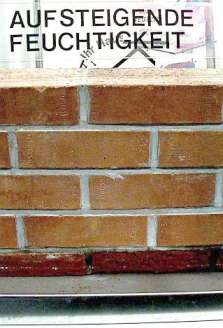
Caution: Not everywhere, where 'ASCENDING MOISTURE' (= 'AUFSTEIGENDE FEUCHTE') is written, dampness will ascend, even
not after 5 days watering in a swimmingpool!
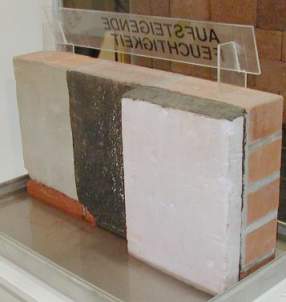
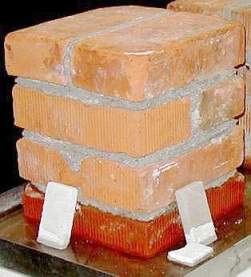
Also the concurrence does not succeed in letting the 5-days dampness ascend beyond the first joint.
There it can wait up to harmaggedon.
In beautiful Hamburg the harbour walls agree with the laboratory tub. You can only see the water levels of the tides:
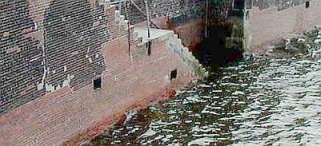 +
+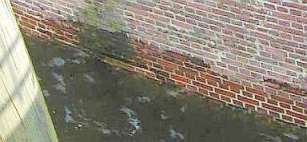 +
+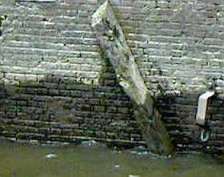 +
+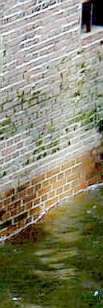 +
+
And also the into the river Regnitz standing historic city hall in Bamberg and its bridge will remain dry without
any chemical , mechanical or electronical damp-proof course:

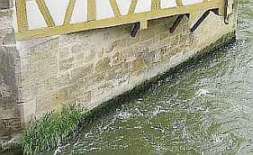
Only the river floods will water the stones near the water level.
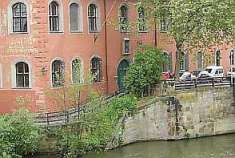
The opposite structures will proof this also. Oh Jesus, what leaky ground drainage system!
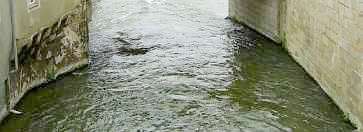 .
.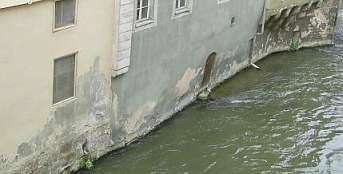
River downward then a catholic miracle: Right at the city hall base no ascending dampness - however the opposite
buildings perhaps nevertheless? But no. Once here lived the beloved chickens, goats and pigs of the burgers. Look to
the “water-rejecting” cementitious plaster and polymere resin coating.
Each masonry bridge proves to you that rising damp in masonry walls does not exist at all. Why?
Continue to read the scientific background:
bausubstanz 7/98: Konrad Fischer:
Additional horizontal sealing of historical brick-work(version supplemented)
“Determining for the degree of the moisture penetration is the absorbency, thus the pore structure of the
used building materials.
Since the humidity always penetrates from the
roughporous into the fine pored layers (never turned around),
is it from importance, whow the pores lie to each other. “
- so Heinrich Schmitt in: Building construction, the construction units and the building structure, bases of today's
building, fifth edition 1974, P. 34. That applies also in the historical masonry work! How do the pores lie to each
other there?
On the soil sole the foundation and base brick-work are built from quite firm, therefore fine pored natural stones.
The connection brought roughporous lime mortar, economically used and leaving empty places between. This mortar missing
ranges and the almost insurmountable capillary resistance at the transition of the fine pored stone to the rough porous
mortar works capillarity-breaking. Over the base the external wall came from natural stones or bricks, often with less more closely void structure as the
stones for foundatations. Thus the old building masters established walls, which offered no possibilities to the ascending dampness.
Starting from that 19. Jh. this specialized knowledge unfortunately was lost, the employment from doubtful experts and idiotic insulating materials began.
In addition there is no transportation for capillary rise of a water gauge in the fine pored stones. Especially if no water level at the foundation foot
lines up.
Also the historical rain protection for the interiors was often reached with simple means: Masonry work with good
stones and lime mortar joints together with rough interior filling. The capillary transport of water was prevented
surely both at the transition from the narrowly and fine pored masonry units to the rough porous lime mortars, as well as for rough porous core filling.
We use these basic knowledge about capillary transport today e.g. with the abdication of additional horizontal
sealings and DPC even in new buildings, on the other hand with the development of specialized salt resorbing plaster with tiny fine pores. The plaster must have a
fine and narrow capillary pore structure, which offers corresponding fine porosity to the withdrawal of salt solution
from the old brick-work. Also with so named water-repellent 'remedial plasters' / Renovation /
Restoration mortar systems according to WTA (Sanierputz) it is noticeable that mostly the micropores will be filled by salt and
nearly none of the hydrophobed water-repellent macropores, sealed inside by polymere layers.
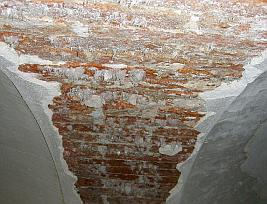
Information to lime, brick, mortar and masonry:
- Mortar from lime and its improvement
- The restoration of plaster and painting on historic fronts - problems and solutions
- The most frequent errors with the use of mortar, plaster and paint of lime
- Renovation mortar systems according to WTA - a harmful and risky alternative for salty and damp walls (see image on the left, where this mortar system failed twice)
- Traditional Craftmanship in Modern Mortars – Does it work in practice? (in english)
- Lime mortar of lime
- Plaster and mortar from lime at the ancient building
- Building materials for walls and masonry in the comparison - with many interesting and rare
building material tables - Important information for building in warm, hot, cool and cold, dry and damp regions.
Problems of modern building materials for restoration, which age by changing temperatures and dampness very
fast and which thereby destroy historical substance. Notice: Cement mortar is not permeable for water, so water is
trapped in the walls. Once saturated, the wall begins to erode.
But why do the notorious base plaster damage and cellar-damp come, simplifying as 'ascending' dampness assigned?
Mostly there is a simple solution to check out the source of the dampness, depending from the source there are simple
solutions for repairing the salty and moistured wall. Very often a expensive analysis equipment is not necessary, not
even a particularly intervening and super expensive measuring of various salty ions until the inner sphere of electrons,
protons and quarks.
1. Salty masonry / brick-work
The historical and modern use offers many possibilities of the aggressive salt load of historical brick-work,
some examples:
- thawing salt or in former times animal flocks resting on roads, ways and places,

With such traffic conditions on public and private ways and places no saltpeter-free walls are possible!
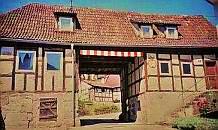 .
.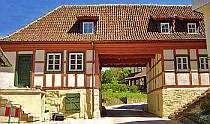
Example of a project for withdrawing the thawing salt and nitrate pollution out of the masonry work of the gate passage
with clay based salt resorbing technics on capillary-open interface (procedure planning and - support: Architecture and
engineer's office Konrad Fischer, 2005)
- later by road construction or yard fill grown area heights at the foundation,
- animals living in townhouses of farming citizen cities, also in the normal workers housing estates,
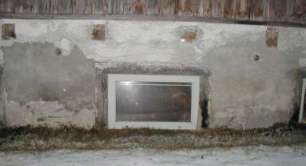
A cow stable in the house is a safe guarantor for salt in walls
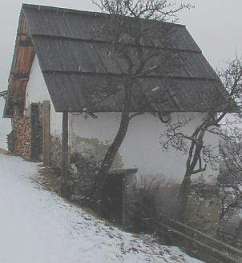
Does a damp-proof course this moisture penetration really affect or stop?
- back pressure out of the sewer with neighborly shit enriching the basement
- Abuse of houses, castles and churches in war times and hunger periods as stable or just normally as doggy or other
pet's homestead
- salt preservation in kraut or herring barrel
- Slaughter house use of the kitchen or rooms in the cellar.
Further modern sources of aggressive salt are cement, trass, hydraulic and silicate building materials as well as
many chemical soups, partly even against 'ascending dampness / rising damp' brought in the wall. Also fight means
against dry rot are salty, they cause water supply to prevent and work therefore pore-clogging.
If salt comes into the masonry mortars, that narrows the pores and facilitates capillary transport from the stone. Many more
importantly is however the hygroscopic water absorption increased now. Salt deposits will go in solution with small air humidity.
What important things will a damp-proof course do against a salt- and condensate-loaded brick-work sucking
hygroscopically all the humidity out of the air? So cheap, more
carefully, more effectively and also more monument-fairly can help a capillary-active simple mortar instead!
2. Condensation
The foundation is in the cold soil. Every day and night, also and particularly in the summer an enormous
amount of humidity comes inside the wall as condensation. The same effect does happen inside the room, when warm air will come in contact
tocolder wall surface. A damp-proof course can do nothing against condensing water.
Effective methods will be:
- The Room Envelope Heating System / The Interior Room Surface IR-Heating System against condensation (Temperierung), also as
support for the drying out wet walls, which can last otherwise many years,
- Single windows as safety condensate surface (inner wall of dampness condensation relieves,
avoids reliably mould growth),
- continuing air dehumidification (well suitably for damp cellars)
- Wall coating with open-porous and damp-compatible coatings to suck up the air humidity maximums. Capillary-closing
polymers as in dispersion, silicone resin and 'mineral paint' (i.e. polymer dispersion silicate paints) however will
moisten up the wall and cause mould.
3. Spray irrigation
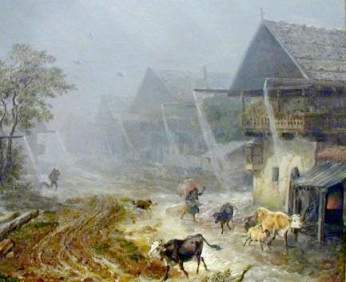
Rainy weather 1838 in Partenkirchen, painter: Heinrich Bürkel.
The base of the wall often is not well protected by the attic roof against direct and splash-water spray irrigation.
By not more used but still open chimneys, leaky gutters and underground pipes in insufficiently consolidated excavation
replenishments (standard of the brave handicraft, because no one will discover it after finishing work at 4 pm!),
oppressive water penetrates into and through the wall and into the cellar and/or base brick-work. External
soil-affecting plasters will suck themselves full with salt and water. Even leaky house water pipes (old lead pipes?)
can moisten up the external and interior walls. What can however do a damp-proof course against all this?
What we need are simple, not expensive solutions. Not industrial shit, spinned out of alchemistic laboratory and witchcraft kitchens. No 'experts', not
water-rejecting and - if cracked and sprinkled by ageing - moisture sucking polymer coatings, no industrial payed scientists and other pseudo neutral
consultants. Only good and honest craftsmanship with oldfashioned lime and clay mortar technics and other simple methods like washing out the salt loaded
walls by pure water out of your water pipe.
Conclusion:
Ascending, respectively rising dampness (wrongly but mainly written as 'rising damp'), in technical literature and by interested circles often stated but
never proven in masonry work does and can and will not exist in walls. Capillary full-sucked aerated concrete stone in the laboratory tub, wet foundations and
cellars likely as water damaged, corroded, rotten, moulded and destroyed building parts, interiors and furniture in big scale or inward increasing salt and
dampness contents in the brick-work are no proof for ascending dampness in the historical existence of our beloved old buildings and monuments. And: You
mostly must not consider a wide range of complicated possible reasons for the moisture in your house - I will promise, there will be very simple reasons which
a fair expert with normal intellligence but honest ethics (does he really exist in our modern world?) will gauge after some minutes looking to your wet
house.
Once again: Distrust all experts who will convince you by monitoring and measurements which will take some seconds like protimeter readings by electrical
moisture meters or even several months up to four seasons detailed laboratory analysis to evaluate and to complete a full diagnosis of your little moisture
in your cold and salty walls. And do never believe in rising damp and any treatments against this hoax. That both will be best for your house and your purse.
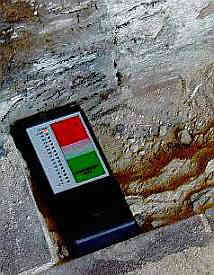
Wood worms, gnawing weevils and all other beloved so hungry beetle friends of good tasting new and old damp wood, moistured and rotten wood is not a proof
for capillary ascending dampness from the damp cellar!
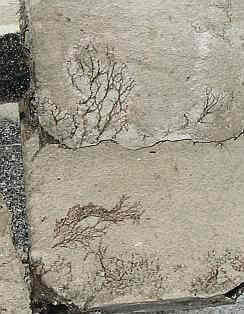
Even not fungus and sponge and wet and dry rot myzel under the base plates of the ground floor. To get rid with those damaging 'friends' you won't kill them
with poisened fluids, cut rotten parts out - not more! - , repair, and keep your house dry (wood < 15% humidity, air < 65%) by
better heating and permanent slow air ventilation. If your house is poisoned, maybe this would be good against such friends, but is
it friendly with you and your familiy?
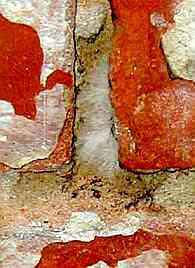
Even not beginning to germinate wet or dry rot myzel (looking like white wad) over burned down remainders (black) in the cellar on the basement brickwork
joining.
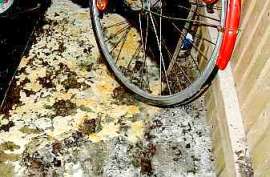
And even dry rot myzel on the cellar floor does not prove ascending dampness from the underground into the floor
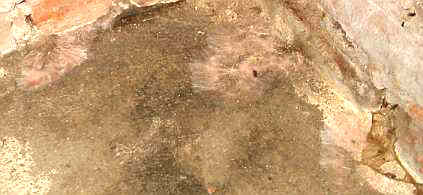
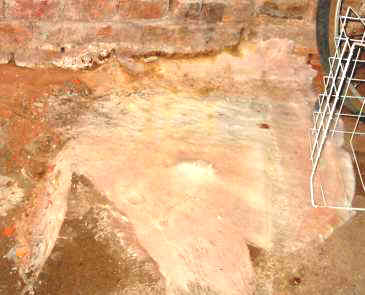
Also not here - dry rot myzel spreading over the floor in the cellar. (Photo: From consulting case, picture: R. Gundelach)
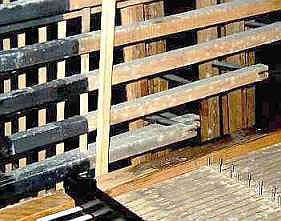
Also inside an organ the moisture with wide spread mildewy mould layers does not come from the underground under the floor
of the church nave. Not insulation under the floor but simple methods can help
like warming up (Temperierung) the shell (envelope) of the organ.
Scientifically reliable practice investigations prove on the contrary the relevant influence of the salt and condensate load
(see monastery Maulbronn, yearbooks of the special research range 315,
Karlsruhe, publishing house Ernst and Sohn). The injection materials
for chemical damp-proof course are anyway strongly “disputed” in the professional world. Straight ones
into damp and salted walls do not penetrate them reliably (see Venzmer:
Building protective agents, publishing house for building industry, Berlin 1997) and separate usually additional aggressive
salts, they will cause in any case unreasonable building destruction with no sense at all.
By additional damp-proof course large, as expensively as possible paid damage is caused to the building: Sawing
cuts, boreholes and injections with doubtful chemicals (wizard`s and
very mysterious hoax-boxes with and without electricity naturally
excluded;-)). That empties owner purses and promotion pot, however
the financing of meaningful repair obstructs. Advantages will get only
to the brave craftsmans, intelligent building material manufacturers involved and suppliers as well as the wellknown consultants,
famous journalists and high decorated planners - business with the fear and anxiousness. And: the crowds of
brave building civil servants in state and church are the best beloved
clients for thus dewatering illusions, spending our taxes and donations - with which consequences? None - or?
Also without additional damp-proof course are damp walls economically and technically good to repair.
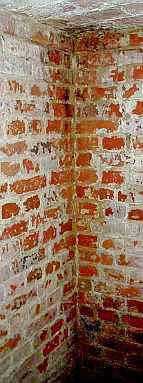
Also these!
Back to the old fashioned traditions and the normal thinking!
 However
usually it will be done without. So the rising damp opens a wonderful playground for the
'scientific experts', the greedy building industry, the 'skillful'
craftsman, the highlyintelligent and well experienced civilengineer and architects up to the court-notorious
specialconsultant - unfortunately also to the unsuspecting judge (apart from the illusion that
insulating material blocks temperature wandering through).
They make the people believe that a masonry work will be the same as a
wick! Holy goodness! In place of purposeful building repair in their
name measures are caused, which fill the purse from the analyse-raunchy
over zealously diagnosing lab technician up to the very poor
consultants to the profit hungry building craftsman and the target meeting companies.
The futile efforts becomes nevertheless the so much trusting owner
feigned as expertise: 'building dewatering / masonry drying
out/brick-work dewatering / cellar dewatering' (or other terms (from the baby pampering?)).
However
usually it will be done without. So the rising damp opens a wonderful playground for the
'scientific experts', the greedy building industry, the 'skillful'
craftsman, the highlyintelligent and well experienced civilengineer and architects up to the court-notorious
specialconsultant - unfortunately also to the unsuspecting judge (apart from the illusion that
insulating material blocks temperature wandering through).
They make the people believe that a masonry work will be the same as a
wick! Holy goodness! In place of purposeful building repair in their
name measures are caused, which fill the purse from the analyse-raunchy
over zealously diagnosing lab technician up to the very poor
consultants to the profit hungry building craftsman and the target meeting companies.
The futile efforts becomes nevertheless the so much trusting owner
feigned as expertise: 'building dewatering / masonry drying
out/brick-work dewatering / cellar dewatering' (or other terms (from the baby pampering?)).
A very effective trick against the owner (works particularly well, if 'only' tax money is wasted) participates, to
gossip elaborately from dos and donts of the most diverse 'dewatering and devapouring and drying out procedures',
to argue against some DPC methods and to sell it in black and white on fine pergament, enriched with fat salt ion
tables from nitrates over sulfates to chlorides only the famous expert and only he by himself was able to decover.
Those unscrupulous 'scientists' even as salespeople will use for salty masonry and plasters useless humidity meters and
other, maybe better analysing tools to convince by the godlike authority of data and numbers. Some offer their service
as 'free house check' - only to plunder you afterwards. Poor owners of Victorian and Edwardian buildings, also
bungalows and other buildings in the U.S. southern, nothern and bible belt states 50 years and over over he whole world,
where highly specialised experts suspect the exhibit rising damp and look for so trustfull clients! They also peer for
Do it Yourselvers - DIYs. Only purpose: Selling some useless but harmfull system of chemical injection of siliconated
poisons, electrical or magnetical hoax or other miracles which need a good driller, nailer, sawer, plasterer or
something else. Are you one of them?
Then the most effective outplundering trick: The king of moisture mimes the most respectable of all consultant
experts and complaines about the oh so bad 'hoax boxes' and little air pipes in foundation walls, as required
also insulting the electrical osmotic pseudo technics, maybe justly. But with no word coming with actual and correct
knowledge around the real capillary situation. Only to recommend: 'for better security' - the most expensive of all the
senseless treatments, the ultimate result of scientific founded 'diagnosis' and 'therapy': horizontally wall sawing,
water-proof course of slate, water repellent bitumen impregnated felt, lead or stainless steel or plastic sheet and
covering the whole crime by 'remedial' plaster with hydrophobe / water repellent sealed pores and a big load of worst
cementitious garbage, coated with an awefully inside water rejecting 'waterproof paint'. Maybe also drilling, heating
out the thousands of irrigation holes (to give the injection pump a little chance to fill more then the new hole in the
surrounding of waterfilled pores) and then injection of some dangerous alchemycal witchcraft soups or hot parafine /
paraffine / paraffin wax sauce which may harm both your health and your building. Costs per hole and liter.
Such charlatanesque academism you can find everywhere, enriched by pseudoscientifically blown up papers. That can
surely convince each customer, also in the public boards of building maintenance and State Historic Preservation
Offices (SHPOs) worldwide. Latinising word use (f.e. 'efflorescence', 'capillarity migration' etc.), sidelong spinning
of ion's plusses and minusses, nitrates, sulfates, chlorides, glauberites and Glauber's salt will affect adoring
kneefalls, also of the healthiest skepticists. The cakespert - let's say the chartered surveyor - must know it
nevertheless. By gosh, Holy Moses and damned motherfucker!
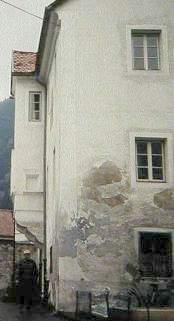
What is that?
Up, off, in, out, on or through ascending dampness?
Topic entrance: The capillarolog's mystery
A wide range of useless building treatments are used in such a way. In Bautenschutz+Bausanierung number 7/01 came
the authors Professor Dr. rer. nat. H. Venzmer et al. from Dahlberg Institute Wismar, under “dampness
protection, the technical Gretchen-question, are applicable electricalosmotic dewatering procedures?” after
appropriate research on P. 57 as conclusion to common methods to the result: “that electricalosmotic
techniques, which work only with minimum voltage and large electrode gaps cannot obtain useful results.”
In the test rows it had become clear that with the procedures no considerable water transportations are to be obtained
by the building-typical capillary systems. Beautifully silly, who gave his hope and money to this. Look:
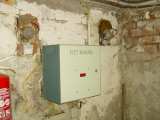 .
.
 .
.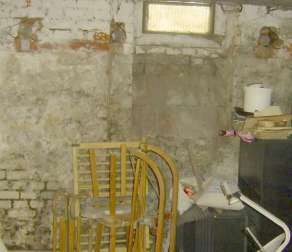
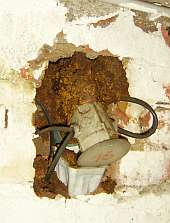
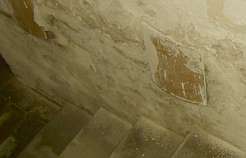
From my building consultation
One of the most miraculous engineer methods for the futile masonry drying and desalting.
The 'active electrical-osmosis / electro-osmosis' in the open and covered installation after some years:
In soil, wall and brutally made holes rotted salts and dampness without end, victimized
offer anodes, current consumption of electricity.In sum: Active dewatering of the owners purse!
After such typical flops you must be prepared to hear:
The most well-known excuses of the dewatering Charlatane
(supplemented after Edmund Bromm, a little completed by me)
'You had a damage caused by water!
You air wrongly!
Your plumbing pipe must be leaky!
Water cames in from downside!
The base plate must have a crack!
Pressing water must come in!
Your plaster is defective!
Your plaster has too much salts!
In your brick-work are too many salts!
You must produce too much condensation water, because the area is wrongly used!
Too much condensation water, because damp summer air came into the area!
The heating had a defect!
Your laundry dryer is exhausting too much damp air!
The overflow did not function!
The groundwater rose!
The water comes through the chimney, because no cover is present!
A setting at the house led to water sucking cracks!
The equipment must be operated 30-50 years, which last!
In your house there is particularly much dampness present, there can success not so fast show up!
Etc., and so on'
Specialists in this house- and cash-destructive doing around the dewatering are approximately the
technically uncertain planners. They are the most oafish victims for the incentivgranted whispering of the smart building
industry. Give a building fool a necktie, already he will convince! Construction costs-increasing by senseless measures fill in
addition the purse, without any efforts of thinking. The experts supports itself mutually
with special remedial plaster 'WTA', the senseless
insulation and window exchangeadoring wrong building norms, bad
diagnoses and shooting with cannonballs to sparrows: So the moistured buildingis, bored, insulated, DPCed, sawed,
sprayed, heated in accordance with electrificated osmotic desalting techniques, only to get maximally holes into the owners purse, often
also under waste of the funds of the incapable monument conservator. Only one is not made: the problem solved at the
roots and salt and dampness of the wall durably reduced and/or eliminates. The consultants, who
express themselves expertful for the dampness load, draining and dewatering of
buildings and bring those never existing 'ascending or rising dampness' in the
discussion, are particularly dangerous, also if they mention it only as a subordinate of
several possibilities. Thus easily the most senseless treatments without any good effect develop
Tip: If you had been already flopped and dehumidifying was promised:
After measure wall dampness before the remedial treatmont measure again, but please with same weather
conditions temperature concerned and humidity of the environment as before.
Do not frighten - despite new hydrophobe / water repellent cementous plaster as demanded
supplement and very important tool of disguising the failing of any DPC it will now be clearly damper.
And now recourse?
A respectable consultant should say regarding damp walls directly: 'Ascending dampness in brick-work systems cannot
exist for technical reasons, lets only look, where we find something (oppressive water load of the excavation, damaged
and leaky drainsystem, gutters, gulleys and plumbing pipes, aggressive salt freight in the hygroscopically damp
brick-work, condensate of humid air on cool construction surface, raining in) which causes the moisture and then the
most suitable treatment at smallest investigation and change of the existing construction. Production of fat tables and
expensive moisture and salt research we do not need, it's enough with healthy human understanding (although nowadays
under experts nearly forbidden).'
That is however very rare. And in such a way it does not surprise that some years also to the
industrial advised chemistry weapon attack the thing went totally into the hell:
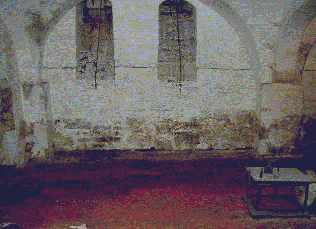 |
Medieval cellar in brickwork with stone pillars and columns at the end of a chemical 'dewatering' by means of damp-proof course,
waterproof mortar joining, outside sealing and surface treatment with the wellknown industrial products.
The dark ranges stress the salt contamination and condensate-strengthened dampness concentration
at soil and wall as reaction to 'silicate/silicone injektion liquid', 'waterproof mortar', 'specialdredge', 'salt barrier', etc.
Salts according to chem. analysis: Ettringite (swelling mineral), Kalisaltpeter, Gypsum, Natriumcarbonate, Trona …
Also all further surfaces of the room (floor, walls and vaults) as well as the central column are extremely salt-contaminated and crumbling.
|
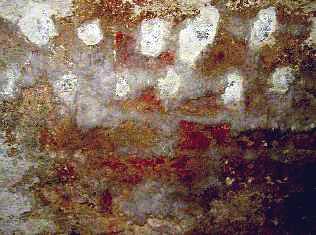 |
Out of the injection ranges and among them cotton-wool-like salt beards grow several centimeters long.
The surfaces of the brick cellar crumble, splitting of dusty sheds and shear off.
Total destruction of the architecture surfaces.
Here the brought in chemistry soups carried again once whole work out. |
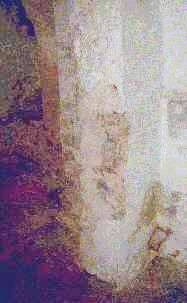 |
The wall pillar
of the passage dissolves into its components.
The salt breakup already out-broke cubicdecimeters of the right edge. |
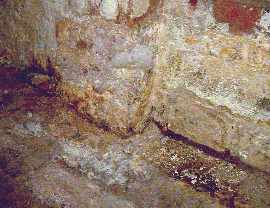 |
From the soil under the chemical 'damp-proof course' salt mountains grew up - a salt pit?
Salt Lake Pity?
Salty flowers for the buried monument, so well preserved by famous experts.>
|
All this happend some years after 'repair' has done. The
implementing company was far away, no architect seizable. It needs some time until meter-thick brick-work from
outside coated with waterproof plaster, filled up by chemical liquids, additional inside a lot of
condensing dampness from warm air into cold surfaces became really drunken and salty reaction products of the miraculous
weapons of our brave building chemistry will grow out of the wall. Be only patient!
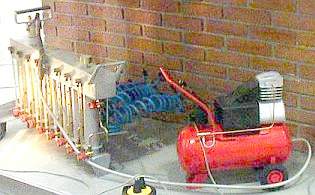
Still another drying casual fair installation of that monument fair Leipzig 2004:
There is probably no better playground for the construction industry than the damp wall.
The outstanding expert intelligence of the planners, monument conservators and owner are thanks.
Technically correct measures would have been for example:
1. Raise the temperature level of the condensate-endangered construction surfaces over the air temperature in
the room by simple means like a open installed warm water pipe around the outside walls (Room envelope heating system) or other
cheap heating systems.
2. Controlled dry and wet cleaning of the damaging flowering salts in alteration with salt analysis.
3. Repair the brick-work, joints and plaster by only pure hydratic (no salt filled 'natural' hydraulic!) lime mortar and lime wash, exchange of deteriorated
construction parts as required.
Cement mortars are loaded up with aluminate salts (C3A), which will react under the given wet circumstances with calcium sulfates in the
moistured wall to really explosive swelling minerals (ettringite, thaumsite), which are responsible for new salt load and further damage!
Hydrophobed and hydraulic 'remedial plaster' (Sanierputz) - the big thing on the phony german repair market - also is responsible
to swelling salt reactions, much to high cementitious firmness and high thermal expansion and will often separate from 'weak' lime mortared underground
as well as hydrophobe salt blockade under the wall coating.
4.Renouncement of vertical sealing outside with bituminous layers. It does not work anyway in many cases at all. Seal a historical foundation base with
fissured surface and full of clefts in accordance with regular norms. Much fun! And good time for the necessary drying times before mortar will be a
correctly working underground for the bitouminous or polymeric glue soup. Also the often necessary sections work is then a true
hoax with no good results at all. Besides the earning of a lot of good money by doing this for the company, it's trash.
Alternative: Repair of leaky underground rain water and - with given leaks - also waste water pipes. If necessary sealing the water touched foundation
walls with clay/sand-bentonite-mix. Inexpensive, for many centuries proven, ever lasting solid, compact and dense.
Important: The adequate evaluation and selection of the clay. It must be able to be consolidated to a minimum
permeability. And good old fashioned craftsmanship. Have you seen it somewhere yet in your life? Look furtherwards!
5. No injection of salt-splitting chemical DPCs, no other worthless and senseless additional horizontal barrier at all.
6. And neither believe an inexperienced cheap planner, nor a docter, professor or salesman of chemical industry and
industrial granted university and free laboratories. Despite they may be clothed with the most beautyful neckties and
promise the most wonderful christmas gifts.
The classical errors in the usual market methods against the wall dampness are (enumerating not finished!):
1. The sources of dampness are not correctly analysed - for lack of knowledge, for lack of preliminary investigation (caution: it does not have to be always
the typical experts investigation with laboratory support, which under no circumstances can assure correct analysis of the building problem, not even suitable
therapy suggestions!), owing to interest in interspersing the own procedure.
2. For dewatering recommended treatments and remedials are accomplished, which can do nothing against existing dampness freight, like e.g. hygroscopically
active salting in the wet brick-work and/or condensation. Therefore become senseless & expensive technics usually with still more senseless and likewise
expensive procedures like e.g. 'remedial' plaster combines, in order the ultimative failure as for a long time as possible to disguise. And by which means will
all the joke procedures dry out the lot of water from the building substance? If I throw a bituminous layer into the lake, dress it additionally with pond
foil, will the lake be drained by this?
3. Functioning treatments are omitted, since the dampness situation was wrongly analyzed. Often it could be so simple, but this
will bring not enough money in the purse.
4. The salesman advisors or of them dependent planners recommend without honest estimate of the situation anyway only 'the own' remdy, usually a combination
of ineffective damp-proof course with dry-blocking plaster and so on. A dewatering, a desaltation, a 'repair' as 'healing' will not happen, even if long lists
of customers, already done projects, usually from public and clerical building offices and church, shall prove the wonder of industrial hoax. Prove it by
yourself - it is worth as healing experience.
5. The 'remedies' may cause even health damage - from the maybe poisoned chemicals and the furtherwards moistured building after bad treatment with therefore
risk of mould and bad conditions to live in.
Supplement (Titles translated, original here):
1. Research of the Dahlberg institute for diagnostics... Wismar, to reread in the conference volume of the 9. Hanseatic repair day 'plaster repair',
Kuehlungsborn 1998, published Berlin 1998:
'There are actual critical remarks to the existence of the ascending dampness. [...] It is referred completely rightfully to
the fact that at historical buildings the dampness admission from air outweighs in particular opposite from the underground of the building, because high
concentrations of soluble salts play a dominating role.
This problem is of importance, it must further be discussed already simply therefore, so that the use from procedures to the drying process is not
overestimated by the additional installation by horizontal water-proof course.'
(Venzmer, Lesnych, Kots: Model tests for the drying behavior of repairing plaster-coated bricks)
2. Fraunhofer research institute for building physics IBP Holzkirchen,
to reread in: Elke Nürmberger: 'Building research, laboratory in the open air, the Fraunhofer research institute
for building physics IBP maintains the world-wide largest outdoor exposure test place in Holzkirchen', in: ARCONIS 1/99:
'Ascending dampness: This diagnosis is frequently not correct, because
the transition resistance between different materials, for example brick mortar, is very high. The climbing height is with brickwork
therefore about 20 cm, with ashlar masonry can it be somewhat higher.'
3. Helmut Künzel: 'Building physics - history(ies) No. 17, Ascending dampness: Large question mark!,' in: ARCONIS 4/02:
“[...]
Decades ago into the close past brick wall samples by different laboratory tests were placed
into a water tub, in order to seize the ascending dampness
quantitatively. Always it was determined only moisture penetrations
over two to three stone heights. That contradicts all the experiences from
practice with moisture penetration pictures over to two floors. [...]
Explanation: The water absorption of brick-work from stones and mortars
is determined considerably by transition resistances between stone and
mortar and/or mortar and the following stone. The conception that a
brick-work from well sucking brick and well sucking pure hydratic lime
mortar is likewise well absorbent, must be corrected therefore. The
mortar with direct water contact is very absorbent,
the water absorption from a damp brick is however because of the
transition resistance very many smaller. [...]
Result: Ascending dampness does not occur in practice as frequently as
diagnosed and as treatments of repair against it in the past had been
done. The actual causes of the in practice arising dampness
damage are to be due mainly to salt enrichments in the brick-work
(wall saltpeter) and to summer condensation. [...] Therefore an
additional water-proof course as barrier layer (in the foundation) is
actually not necessary. [...]
To attach so far dampness damage of the described kind to old buildings brought with
it in connection that it is usual only for approximately 1900,
horizontal barriers underneath the coming up brick-work and that
therefore “ascending dampness” did not arise with
later buildings any longer. In addition, one can bring the improvement
to the environmental sanitation with this time in connection. [...] It
needs to have applied only an expert, who was not familiar however with the problems of the salt influence and
the hygroscopicity, the horizontal barrier hypothesis and thus it by
the professional world was taken over. Such misunderstandings can
have a long life, as we know from the experiences with the
“breathing wall”.
It would be appropriate under described conditions to eliminate the ominous and
from the baby care taken over term “Trockenlegung”[i.e. pampering] from the vocabulary
of the building physics. The treatments necessary in the described cases have with it nothing in common.”
and
“IBP report of 337, 25 (1998) new research results, shortly referred
H. Künzel
Causes of the damage with old buildings: Ascending dampness, hygroscopic dampness or condensation water?
[...] Ascending dampness
Ascending dampness (Rising dampness) is discussed with the remedies horizontal
barrier or injections many more frequently as cause of the
damage, than it arises in practice. Outside walls of surge tanks or
quay walls, which have direct inflow of water, are at the most damp up
to the second or third stone situation. This corresponds to the results
of measurement, which were won in the past in different institutes
[picture reference]. While with a continuous mortar disk or a finery a
large climbing height is to be registered, this is very small with
brick-work and ends with brickwork for instance with 20 cm. The reason
for it is that between different materials such as bricks and mortars a
large transition resistance is given. Ascending dampness is to be
expected therefore with brickwork up to a height of approximately 20 cm
and can with ashlar masonry with a large mortar portion somewhat more highly occur.
Hygroscopic dampness (wall saltpeter)
With higher visible wall moisture penetrations than some decimeter - often over the
ground floor away - usually hygroscopic salts [out at the wall
high-squirted excrements] are the cause. The larger the amount of salts
is, the larger is the lasting humidity content, which
adjusts itself in the external plaster and/or brick-work due to of
dampness absorption from outside air. [...] There the improvement of
the city and village hygienic situation during the turn of 19. to 20.
century for instance with the introduction of horizontal barriers in building walls
happens coincidentally, the decrease of the visible wall dampness
falsely is pretended to the latter circumstance. [...] “
4. Publication Bavarian Building protection special
planning, division of silicones, Wacker chemistry, Bayplan,
Munich, to reread in: Helmut Weber: 'Antibugging, repairing
plaster systems in the long-term employment under less favourable
conditions' bausubstanz April 1999:
“In the last decades one tried again and again to eliminate damp brick-work
and plaster damages by additional sealing treatments in the horizontal
and vertical range durably.
One had to determine again and again that this is only conditionally possible,
there - as today generally admits - many of the visible damage into
damp and salt-loaded brick-work primarily must attributed to the effect
of salts. These dissolve in the water, move by the brick-work and
concentrate, where the most favorable evaporation ranges are. They lead
then to mechanical damage in the plaster and brick-work range by
crystallization and hydration on the side and to an increase of the humidity content by hygroscopic effects.
The dampness household of the wall is affected by this hygroscopic water absorption
lastingly in the unfavorable sense. “
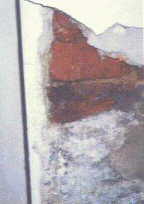 Remedial
plaster does notwork as expected! Often it sheares off from the historical underground
Remedial
plaster does notwork as expected! Often it sheares off from the historical underground
5. Absorption of
water in a sample of brick and mortar: http://www.phys.tue.nl/nfcmr/restop04.html
To the conclusion:
Don't believe in rising damp!
Last, but not least:
For the historical background of the salt load at the building writes Otto Kratz in Sueddeutsche Zeitung on
weekend, 10.11.01 (S.I):
'Drastic describes the technologist F. Knapp 1847 the increasing of saltpeter
everywhere due to the at that time quite generous hygenic conditions.
“In strong populated cities in close roads, where the excrements of the draught cattles, waste of the slaughterhouses, rinse
waters from the houses, wastes of the markets, where is sold meat, poultry, fish and other food, where these and many such things mix
themselves with liquid contents of the gutter are in continual rot, you can see as mortars at the base of the outside walls
will gradually corrode and be covered with snow-like, white, crystalline flowering, named “saltpeter corrosion”
Still in 18. Century used the Bavarian army particularly plentiful
wall salpeter of the manure-washed around of farmhouses. Envoys of the saltpeter commission protected
by soldiers attacked defenseless farmsteads in the morning-grey, tore
the floor planks out and scraped Saltpeter off. The farmers, who at all
that did not please, interspersed with support of the church the fact
that at least that part of the living room, which served the religious
devotion remained spared. By demonstrative and plentiful arrangement of
Herre Gods Corners [Herrgottswinkel], house altars and holy pictures
one could trick out the saltpeter commission. This trickishness justified to
today the continuous reputation of deep religious piety of the bavarian countryside people.'
This farm house wall filled by saltpeter would be beloved by the saltpeter commission:
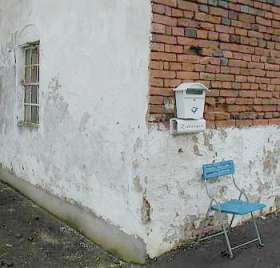 .
.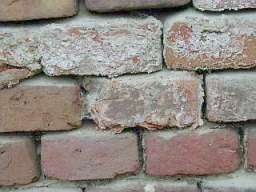
Consider how isolated areas of salt contamination contradict the theory of rising damp.
Another Fraud: The U-value. Click on the figure to find out more!
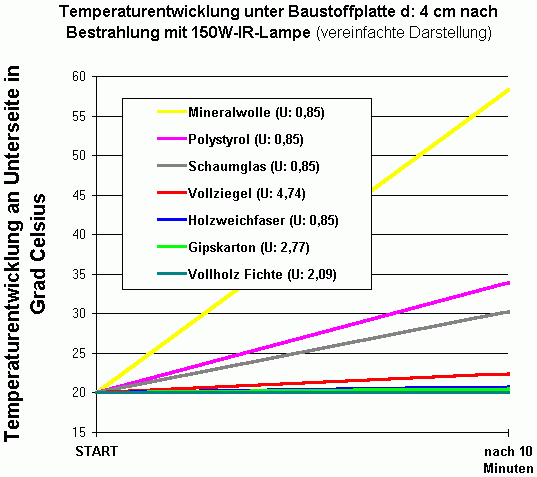
This figure of our 'Lichtenfelser Experiment' shows the material temperature
after 10 min IR-radiation by a red lamp bulb. Temperature in the beginning (START) 20 °C. Each
material of different U-value/R-value is 4 cm thick, the
temperature is measured under the material opposite the radiated surface. Materials from above: mineral
wool/fiberglass, polystyrene, foamglass, solid brick, wood fiber board,
gypsum cardboard, solid pinewood. Result: The U-value/R-value is a completely
worthless value for building construction under real situation. Lightweight materials can not store the solar energy and
protect your house against sun heat in summertime. Broadcasted by several TV stations in Germany.
More details.
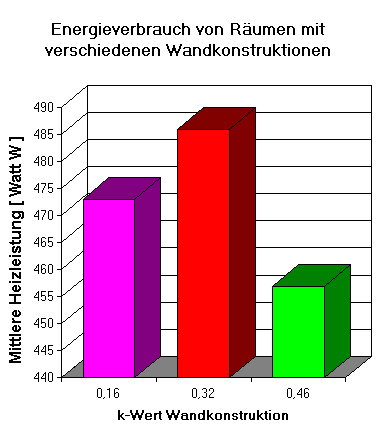
This figure shows the heating energy for three rooms with different walls and different U values/R values/k
values (k-Wert) during a winter period, proved by Fraunhofer Institut for Building physics. The by thermal insulation covered walls
0,16 and 0,32 are worse, the not insulated brickwork wall 0,46 is best! Details.
Extra: A wonderful book review on www.pavingexpert.com regarding the rising damp fraud, autor: "danensis":
"The rising damp myth, by Jeff Howell
(Nosecone publications)
Jeff Howells is not one of those academics, who has never got dirt under his
fingernails, nor is he a builder, with pet theories of his own with no
scientific basis. He is a lecturer in construction technology, who
worked on building sites in order to supplement his salary and pay his
mortgage. He's a trained brickie with a degree in science and engineering
So when, in 1993 he set his students the task of comparing different types of damp-proof course, he fully expected that
the four pillars of bricks, standing in trays of water, would soon
demonstrate the phenomenon of rising damp. Of course (no pun intended)
the ones with the damp-courses would only be damp up to that level, but
the surprising result was that none of them showed any sign of rising damp.
He tried more porous bricks, he tried different types of
mortar, he even tried bringing back lumps of Victorian wall cut out of
openings in buildings on which he was working, but none of them exhibited this phenomenon of rising damp.
During this time Jeff visited the Netherlands, much of which is below sea-level, and where
any excavation rapidly fills with water, but he found they didn't need,
or use, damp-proof courses. They're never troubled by rising damp!
Jeff then started looking at literature from the Building Research Station,
and found that the phrase "rising damp" didn't even exist before 1951.
BRE 245 gives a simple way to distinguish between masonry which was
damp because of condensation or rainwater, and that which was affected
by ground water, which was likely to contain dissolved salts. Bob
Sharpe, the BRE's foremost expert on dampness in buildings, said he had
never seen a genuine case of rising damp in a British house.
The book goes on to describe the rise of the chemical damp-proofing
industry, and the errors made by using meters designed for measuring
moisture in timber, for measuring masonry. Apart from the fact that the
masonry is likely to be covered by wallpaper, and plaster, both of
which absorb water, he explains why the results of measurements even on
bare masonry are likely to be inaccurate
There is a chapter where Jeff tries injecting bricks with damp-proofing chemicals, and
then sawing them in half to see how far the chemicals have penetrated.
He shows that when damp-proofing fluids are injected into damp masonry,
substantial amounts of moisture remain.
The book discusses the part mortgage lenders have to play in the rising-damp myth, and the
lack of practical training given to surveyors. There's a chapter on
diagnosing the real causes of dampness in buildings, and towards the
end of the book he finally gets the RICS to admit that they are wrong.
Apart from the order of chapters (I'm not quite sure why the chapter on
Protimeters is quite where it is) the book is a good read, and shows
how, if you approach a subject with an open mind, you can overthrow
received wisdom and establish the true facts in a logical and scientific way.
Recommended links
heritage-house.org of Pete Ward (a well experienced negationist of the Rising Damp Myth)-
Survey, report and repair work for damp, masonry, plaster and timber problems - a team of dedicated and enthusiastic conservation professionals in the UK
Damp and Timber Problems - Independent Surveyor (and believer of the Rising Damp Myth, sorry) Patrick Doyle - www.pdoyle.net-
Independent surveyor's site for Damp and Timber problems in Yorkshire and surrounding counties
Exciting discussion ref. 'Rising Damp' in a DIY-Forum:
www.diynot.com/forums/viewtopic.php?p=316903
Topics: masonry restoration, preservation and conservation of historical monuments.
Repair, preservation. restoring, refurbish, rehabilitate and renovation of apartment house, castle, farmhouse, manor house,
villa and tenant house, city hall, water-mill, palace, chapel, church, cloister or monastery and abbey or summer
residence.Mold attack and alga attack, wood worm, wood borer, pine weevil, boring beetles, elaters and longicorn beetle, larva,
clearwing moths, goat moths, wood protection agains insects and dry rot, brown cellar
sponge, white pore sponge etc.

Homepage: Old building and care of monuments information
Certified Links to this page:
Your Links?
 Mould Attack - What
can help? (english)
Mould Attack - What
can help? (english) English
entrance site
English
entrance site 